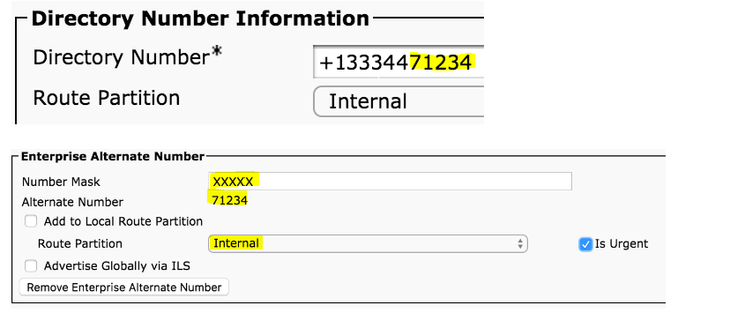- Cisco Community
- Technology and Support
- Collaboration
- Unified Communications Infrastructure
- Re: CUCM Design question - 5 digit dialing - abusing translations?
- Subscribe to RSS Feed
- Mark Topic as New
- Mark Topic as Read
- Float this Topic for Current User
- Bookmark
- Subscribe
- Mute
- Printer Friendly Page
CUCM Design question - 5 digit dialing - abusing translations?
- Mark as New
- Bookmark
- Subscribe
- Mute
- Subscribe to RSS Feed
- Permalink
- Report Inappropriate Content
11-03-2022 02:39 PM - edited 11-08-2022 01:35 PM
The goal here is to simplify CUCM 5 digit dialing by using route by next hop translation patterns to different CSSs.
Currently, our dial plan is sort of using CSSs relative to area code, with partitions for each location. This requires us to assess overlap and if one is found in said CSS, we have to create a new set of overlap CSSs (device, cfwds).
The main thought here is that we can entertain essentially a sort of wildcard access code on the leading 5 digit because we don't use 7 digit dialing, and our extensions are using 11 digits. We can create a lookup CSS that pattern matches point to, and match the internal 11 digit, thus sort of universalizing translations. Here's an overview of the CUCM config:
1. CSS for Device
Contain the PSTN PT and main PT
2. CSS Line
Contains a PT with a [2-8]XXXX xlate - this routes by next hop calling number to CSS-Filter
(also contains the blocking PTs)
3. CSS CFWDs
Contains a PT with a [2-8]XXXX xlate - this routes by next hop calling number to CSS-Filter
4. CSS-Filter
Contains PT with xlates that match known internal extensions (i.e. 120924XXXXX). If there is a match, it transforms the called number with the calling number prefix. This also routes the next lookup to a the original CSS.
We have a mixed campus that overlaps three 7 digit ranges, so that is a bit trickier. I had to add an additional hop to a different CSS, then transform, and perform the lookup.
Admittedly, this feels pretty cheesy, but with the current dial habit demand and the variety of numbers to avoid overlap (multiple 10 digit blocks/ranges), it deserves it. What tests I've performed haven't led to a stopping block yet. I don't know if there is anything about this I'm not seeing or might cause issue down the road? Any thoughts here would be appreciated. Thanks!
- Labels:
-
Call Control
-
Unified Communications
- Mark as New
- Bookmark
- Subscribe
- Mute
- Subscribe to RSS Feed
- Permalink
- Report Inappropriate Content
11-07-2022 12:45 AM - edited 11-07-2022 12:46 AM
I may be restating things you already know, but the rules of match evaluation are pretty well defined. Absent things being marked as urgent, then most precise match wins. If there are matches of equal precision, the one in the partition highest in the effective CSS wins.
That leads into another topic. The effective CSS is the line CSS prepended to the device CSS. It is really important to remember that or you may get confused by how your calls route. DNA is your friend if you want to know what CM will do. https://<CM>/dna
My current preference is to use +E.164 with the idea that call destinations are normalized prior to routing, and localized (if needed) at the local gateway when then go to the PSTN. Keep translations for all inbound numbers in a single partition and reference this when normalizing. That way you keep internal calls on net regardless of how they are dialed (tromboning calls to the PSTN for internal destinations is a pet peeve of mine).
I didn't see you mention how you handle non-did's. I assume you have some plan for that since there always end up being some internal destinations like that. I know my response is kind of general, but I wasn't able to pick out a specific question in your post.
- Mark as New
- Bookmark
- Subscribe
- Mute
- Subscribe to RSS Feed
- Permalink
- Report Inappropriate Content
11-08-2022 01:34 PM - edited 11-08-2022 01:40 PM
I went ahead and diagramed this out.
This works. It reduces the need to have specific CSS/Partitions/Xlates for each of our branch offices. However, I just don't know if there is something I'm missing in terms of unintended consequences. Please let me know your thoughts.
- Mark as New
- Bookmark
- Subscribe
- Mute
- Subscribe to RSS Feed
- Permalink
- Report Inappropriate Content
11-08-2022 06:53 PM
@Clutz5250
First of all, very nice diagram. As for your 5 digit dialing setup, I personally don't see any major problems but I did want to point out a couple of pros and cons.
Pros
No dial plan overlaps
No need to add the 5 digit extension as an alternate extension under the voicemail box (for calls go to voicemail)
Cons
5 digit dialing is limited to extensions within the same area code as the calling device number
You will need translation patterns for each and every DID block
Another method that you could use is the "Alternate Enterprise Number" on the extension configuration page. The pros and cons of this method are as below (exactly the opposite of the ones I mentioned above).
Pro
5 digit dialing is NOT limited to extensions within the same area code as the calling device.
You won't need any translation patterns
Cons
Overlaps (if two or more DIDs end in the same 5 digits)
You have add the 5 digits as an alternate extension on the voicemail boxes in CUC.
See screenshot below.
Discover and save your favorite ideas. Come back to expert answers, step-by-step guides, recent topics, and more.
New here? Get started with these tips. How to use Community New member guide





